With remote teams spanning multiple time zones and the need for quick decision-making, a typical modern-day workspace is rife with communication challenges.
Because it’s not just about communication; it’s about getting the communication right.
Luckily, the market is inundated with workplace communication and messaging tools to help you streamline team collaboration, foster a better work environment, and enhance your team’s productivity.
In this article, we’ll discuss the must-have communication tools for your workspace and the ensuing benefits of using these tools.
Benefits of Using Workplace Communication Tools
The benefits of using workplace communication tools are aplenty.
Here are some of the major ones:
1. Streamlined communication and collaboration
Streamlined communication and collaboration are at the heart of any organization.
Without these two in place, your employee’s trust and morale will most likely dwindle.
Let’s face the facts:
In a survey by Forbes, 43% of participants claimed that poor communication reduced their trust in leadership, while 48% said it affected their trust levels in their team.
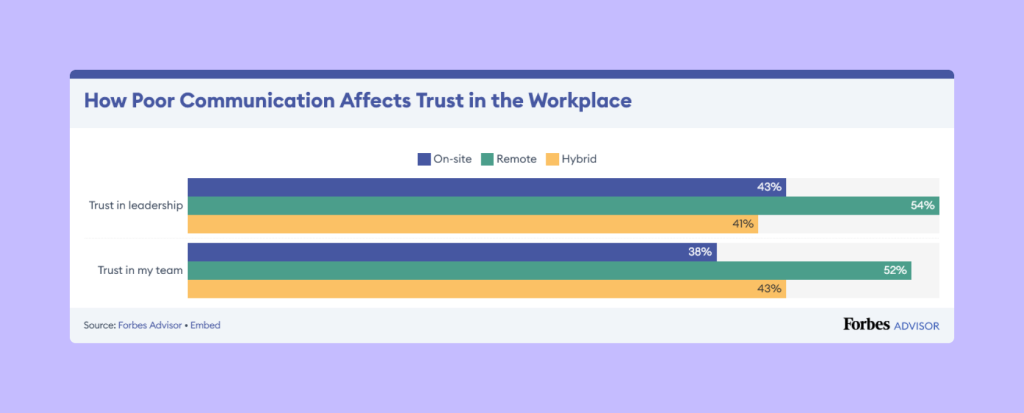
Now imagine your team as a well-oiled machine, smoothly exchanging ideas and information and seamlessly working together towards a common goal.
When communication and collaboration are streamlined, productivity soars, and projects get completed more efficiently.
This is where workplace communication tools come into play.
2. Documentation and knowledge-sharing
Scattered digital folders. Documents to be signed. Client and employee contracts.
A typical organization has to deal with tens and hundreds of documents.
Unless you document and share knowledge efficiently, it will all dissolve in utter chaos.
Workplace communication tools help you avoid just that.
For example, you have documentation tools like PandaDoc that help you centralize your documents in one place and collaborate over them with your team.
Writer’s Note:
PandaDoc also has features that allow real-time document editing and commenting to streamline communication and collaboration in the workspace.
3. Real-time problem solving
Picture this scenario: Your marketing team is in the last stages of finalizing a campaign.
But as you’re about your launch the campaign, you realize it needs an unforeseen, last-minute change. You need to assemble your team quickly.
But it’s not too much trouble with access to real-time communication tools like Slack, Zoom, and PandaDoc.
You need a quick video chat? You’ve got Zoom and Google meetings.
You need your entire team’s opinion on a document in real time? PandaDoc is your friend.
And if you need to assemble the team quickly, you’ve Slack to send out quick messages to everyone at once.
4. Enhanced productivity
Better communication naturally leads to better productivity.
We’re not just pulling quotes out of thin air, we have data to support this statement:
According to a recent survey by Grammarly, 72% of business leaders claim that effective communication leads to increased productivity, and 60% report that it results in increased employee confidence.
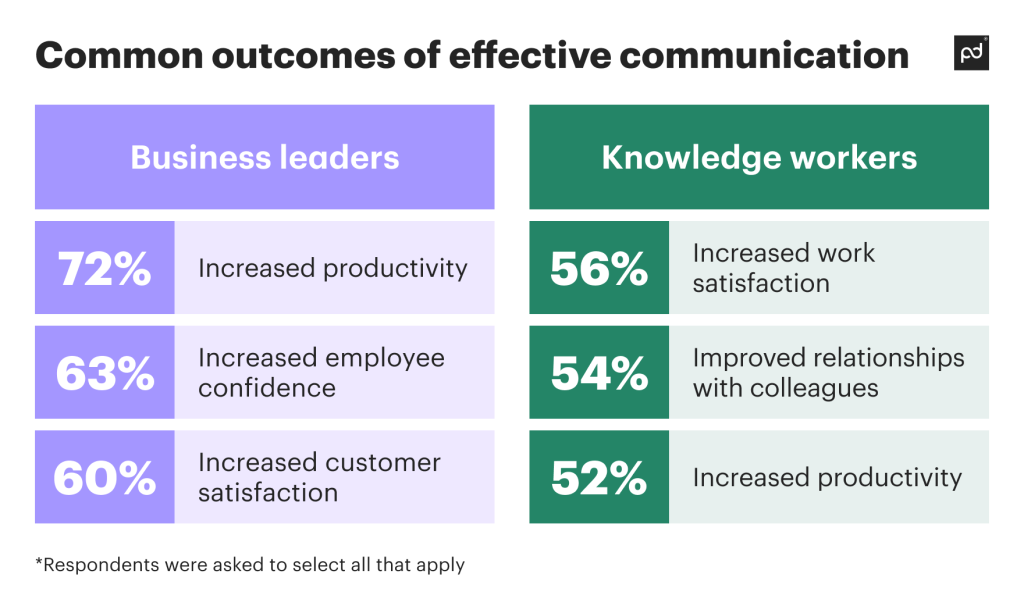
Think of a world without these communication tools.
Rather than working on pressing, more productive tasks at hand, more than half of the time will be spent navigating lengthy email threads.
And with the advent of remote work and global teams, dealing with differences in time zones would also zap productivity.
However, in today’s modern landscape, you can use multiple communication tools to remain productive no matter the situation.
For example, you can use a combination of Slack for real-time discussion, PandaDoc for collaborative document editing, and Asana for task management.
Must-Have Communication Tools for the Modern Workspace
Here are some must-have communication tools that will help unlock success for your company:
1. Video Conferencing Platforms: Zoom and Google Meet
Video conferencing platforms help you conduct webinars, video calls, and virtual meetings with your clients and teams regardless of their location.
They also save time and are considerably more economical than face-to-face meetings.
The best part? Most modern-day video conferencing platforms also come with advanced features like screen sharing and recording, eliminating the need for lengthy note-taking.
Two of the most popular video conferencing tools that come to mind are Zoom and Google Meet.
However, both Zoom and Google Meet have their own strengths and weaknesses.
For example, if you’re looking to host large-scale meetings, you might prefer Zoom, which allows up to 1000 participants.
On the other hand, Google Meet is more suitable for smaller meetings with up to 250 participants.
Here’s a brief overview of both Google Meet and Zoom:
| Google Meet | Zoom | |
|---|---|---|
| Maximum number of participants | 250 | 1000 |
| Starting price | $6 per user per month | $14.99 per user per month |
| Meeting duration limit | 60 minutes with the free plan | 40 minutes with the free plan |
| Screen sharing | Yes (but with limitation options) | Yes (with advanced options like allowing multiple users to share their screen simultaneously) |
| Breakout rooms | Yes | Yes |
| Whiteboards | Yes | Yes |
All in all, Zoom offers more advanced features, while Google Meet is more user-friendly and economical.
If neither option works for you, an alternative you can consider is Microsoft Teams.
2. Instant Messaging App: Slack

Any post about communication tools would be incomplete without mentioning the instant messaging app Slack.
All-in-one communication and collaboration tools like Slack have changed how teams collaborate and communicate in a workspace.
What social media platforms like Instagram are to the everyday populace, Slack is to a digital workplace and business communication.
The instant messenger not only allows real-time communication but also allows you to exchange files instantly, create separate channels with specific team members, and have quick audio conversations.
The interface is also modern, intuitive, and easy to use. There’s no learning curve, making onboarding hassle-free for new hires or new team members.
Other key features of Slack include:
- Slack lets you send or receive text, files, audio, as well as video messages.
- You can add reactions to messages, use emojis, and answer in threads to enhance interaction.
- You can integrate with over 2200 third-party apps.
- It has a powerful search feature that lets you search anything in Slack, including files, people, channels, etc.
Pricing: Starts at €6.75 per person/month when billed yearly. There’s also a freemium plan that has some limitations.
Another alternative you can consider is Microsoft Teams.
3. Cloud-based Document Sharing: PandaDoc

PandaDoc is another all-in-one workflow management and communication platform that specializes in document collaboration.
It lets you create, share, and collaborate on documents with clients and teams in real time.
With it, you can ensure everyone has access to the latest versions of files from any location, so tasks like commenting, e-signing, notarizing, and managing documents become all the more easy.
What makes it stand out from other document-sharing platforms is its library of visually appealing templates for different use cases, which ensures that all department types from any organization and niche can easily leverage templates to save time on document creation.
You also get to access an easy-to-use drag-and-drop editor, which allows you to drop elements into your document, custom brand it, and make templates or create content libraries.
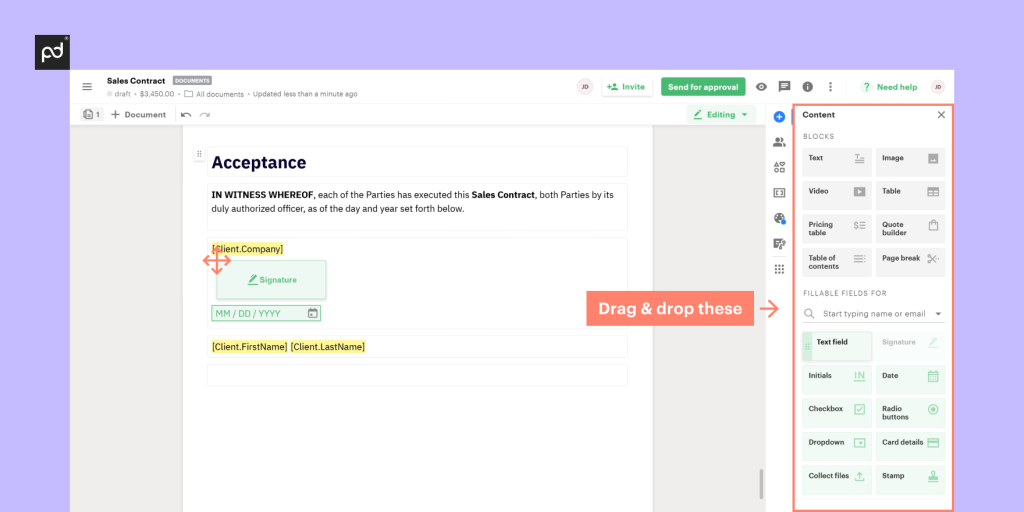
Other key features of PandaDoc include:
- Automated workflows and notifications.
- Complete document audit trail.
- Access to document analytics.
- Extensive integration with other business apps and services.
Pricing: Pricing plans start at $19 USD per user/month when billed annually. (You can also access a 14-day free trial.)
Other alternatives you can consider are DropboxSign and DocuSign.
4. Collaboration and Project Management Software: Trello
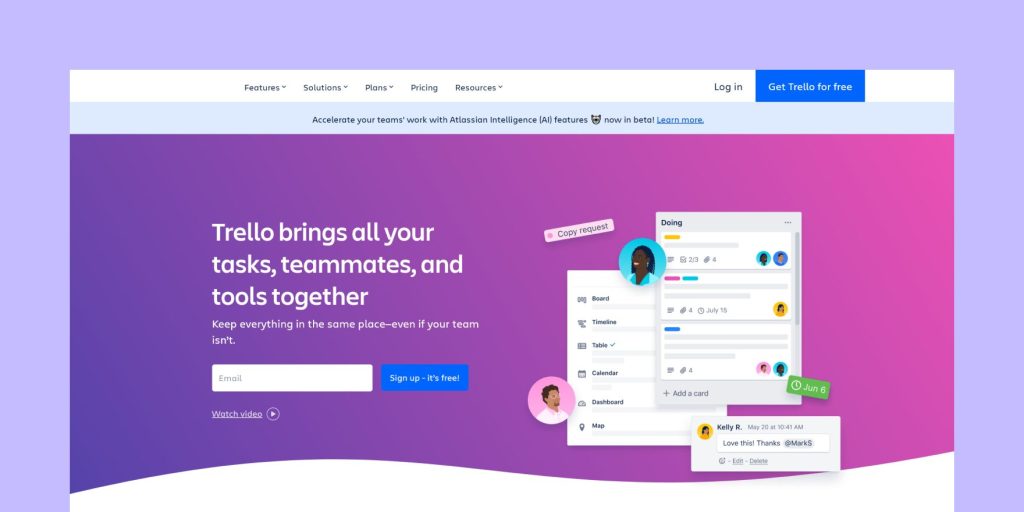
Envision a digital whiteboard with sticky notes you can move around – that’s Trello for you.
Trello is one of the most popular internal communication tools for visual project management and collaboration.
It consists of three major components:
- You start with a board (the big picture)
- Break it down into lists (categories)
- Add cards (tasks or ideas)
Here’s what a typical Trello dashboard would look like:
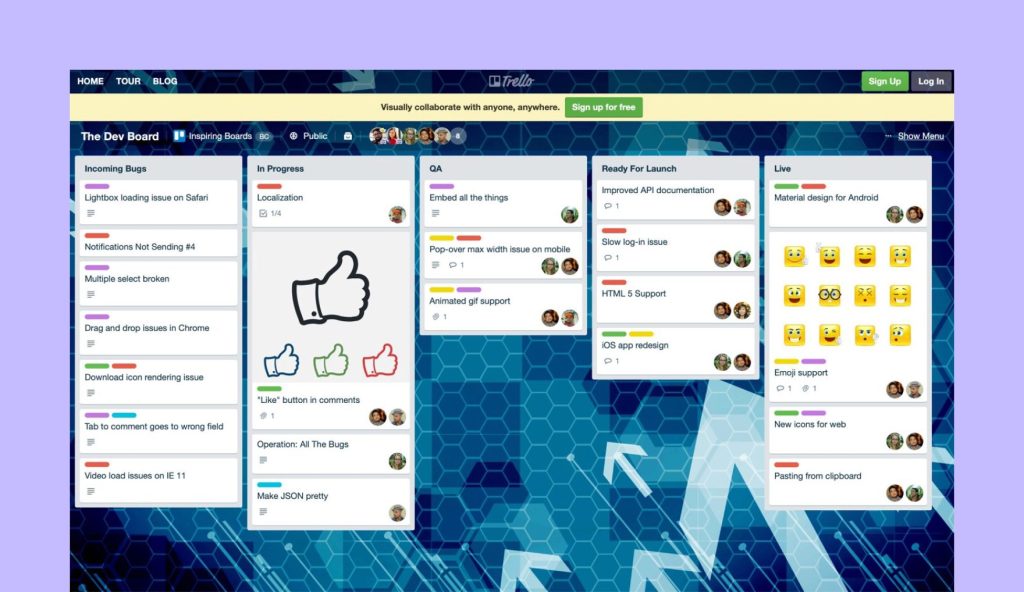
You can assign cards (tasks) to multiple team members, leave comments, prioritize cards by dragging them around, and re-arrange your lists the way you want.
You can also add labels and tags to each card so they’re easy to identify.
Each card can also contain checklists and due dates, which helps keep everyone in the loop and ensures tasks get done on time.
Other key features include:
- Share documents, images, links, and more in the cards.
- Visual workflow with the ability to see what’s in progress and what’s pending.
- Integration with other communication and productivity apps.
- The ability to set up automated notifications.
Pricing: Starts at $5 per user/month if billed annually. There’s also a freemium plan that allows up to 10 boards per workspace, making it suitable for individuals.
Other alternatives you can consider are Monday, Jira, ClickUp, and Notion.
Navigating Success With Communication Tools in the Modern Workspace
There was a time when having effective communication in the workspace was a nice-to-have.
These were the days when the most popular communication channels were phone calls and Outlook. But those days are long gone.
Now you need a combination of multiple communication tools for multiple tasks, including employee communication, file sharing, sharing information, company news, project management, and a lot more.
From video conferencing platforms like Zoom and Google Meet to instant messaging apps such as Slack, document-sharing services like PandaDoc, and project management tools like Trello and Asana, these team communication software tools offer tailored solutions for different communication needs.
The result? Enhanced trust, better teamwork, smooth collaboration, and skyrocketing productivity.
To get started with your own journey towards better productivity and collaboration in the workspace, give these tools a try.
To get started, you can sign up for the PandaDoc 14-days trial and see how it can enhance document sharing and collaboration in your organization.


